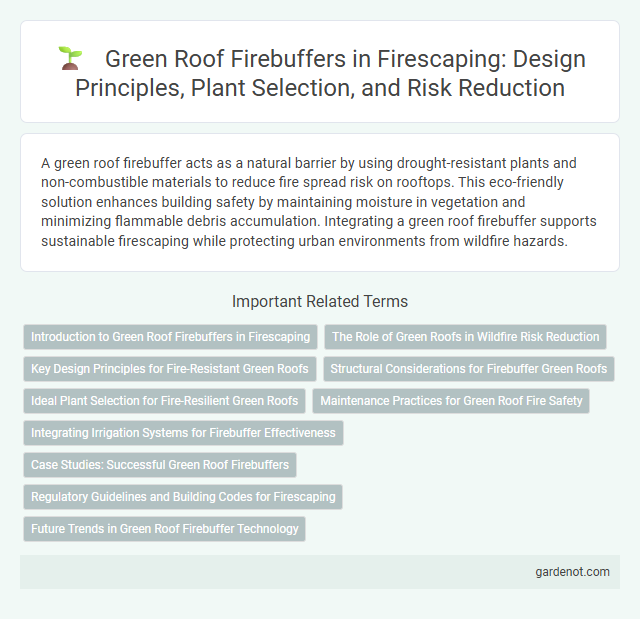A green roof firebuffer acts as a natural barrier by using drought-resistant plants and non-combustible materials to reduce fire spread risk on rooftops. This eco-friendly solution enhances building safety by maintaining moisture in vegetation and minimizing flammable debris accumulation. Integrating a green roof firebuffer supports sustainable firescaping while protecting urban environments from wildfire hazards.
Introduction to Green Roof Firebuffers in Firescaping
Green roof firebuffers serve as a critical defensive layer in firescaping by reducing the spread of flames across rooftops through the use of fire-resistant vegetation and materials. These green roofs incorporate drought-tolerant, low-flammability plants that retain moisture and act as natural barriers against embers and radiant heat. Integrating green roof firebuffers enhances building safety while contributing to urban heat reduction and stormwater management.
The Role of Green Roofs in Wildfire Risk Reduction
Green roofs act as effective firebuffers by maintaining moisture-rich vegetation that slows wildfire spread and reduces flame intensity. Their irrigated, dense plant layers limit combustible material accumulation, creating a natural barrier against embers and radiant heat. Incorporating drought-resistant, fire-resilient plants enhances urban wildfire resilience while promoting sustainable building performance.
Key Design Principles for Fire-Resistant Green Roofs
Key design principles for fire-resistant green roofs emphasize the use of fire-resistant plants with high moisture content and low flammability, such as succulents and native grasses. Incorporating non-combustible materials like gravel or fire-retardant barriers beneath the vegetation layer creates effective firebreaks that slow fire spread. Strategic irrigation systems and proper roof slope facilitate moisture retention and limit fire ignition risks, enhancing overall firebuffer performance.
Structural Considerations for Firebuffer Green Roofs
Structural considerations for firebuffer green roofs include ensuring the roof system has adequate load-bearing capacity to support additional soil, vegetation, and moisture weight. Fire-resistant materials such as non-combustible membranes and insulation enhance fire resilience while maintaining structural integrity. Proper drainage and root barriers also prevent water accumulation and root intrusion, which could compromise the roof's performance during fire events.
Ideal Plant Selection for Fire-Resilient Green Roofs
Ideal plant selection for a fire-resilient green roof centers on fire-resistant species with high moisture content and low flammability, such as sedums, succulents, and certain drought-tolerant grasses. These plants reduce fire spread by maintaining a moist canopy and minimizing resin or oil-rich foliage that acts as fuel. Integrating fire-resistant native plants adapted to local climate conditions enhances the green roof's ability to act as an effective firebuffer.
Maintenance Practices for Green Roof Fire Safety
Effective maintenance practices for green roof firebuffers include regular removal of dead vegetation, trimming overgrown plants, and monitoring moisture levels to reduce fire hazards. Inspecting irrigation systems ensures optimal hydration, preventing plant desiccation that can increase flammability. Routine debris clearance and fire-resistant plant selection further enhance green roof fire safety.
Integrating Irrigation Systems for Firebuffer Effectiveness
Integrating irrigation systems into green roof firebuffers enhances their moisture retention, significantly reducing the risk of ignition during wildfire events. Advanced drip irrigation or automated sprinkler systems maintain optimal soil hydration, supporting fire-resistant plant species' growth and resilience. Consistent moisture levels achieved through these systems improve the overall effectiveness of green roofs as passive firefighting barriers in urban fire management strategies.
Case Studies: Successful Green Roof Firebuffers
Case studies demonstrate that green roof firebuffers effectively reduce fire spread and enhance building safety in wildfire-prone areas. Research from California and Australia highlights that strategically planted, drought-resistant vegetation on green roofs acts as a natural firebreak, minimizing heat transfer and embers during wildfires. These successful implementations indicate that green roof firebuffers not only improve urban resilience but also contribute to sustainable fire management practices.
Regulatory Guidelines and Building Codes for Firescaping
Green roof firebuffer installations must comply with local and international building codes such as the International Building Code (IBC) and National Fire Protection Association (NFPA) standards, which dictate fire resistance ratings and vegetation types to minimize fire risk. Regulatory guidelines often require the use of fire-resistant plants and materials, proper irrigation systems to maintain moisture levels, and clear separation between green roofs and combustible structures. Adherence to these codes ensures enhanced fire safety, reduces ember ignition potential, and supports fire department access during wildfire events.
Future Trends in Green Roof Firebuffer Technology
Emerging green roof firebuffer technology integrates advanced fire-resistant vegetation and intelligent irrigation systems to mitigate wildfire risks effectively. Innovations in sensor-based monitoring enable real-time detection and automated response, enhancing the roof's fire resilience. Future trends emphasize sustainable materials and adaptive designs that optimize energy efficiency while maintaining robust fire protection.
Green roof firebuffer Infographic

 gardenot.com
gardenot.com